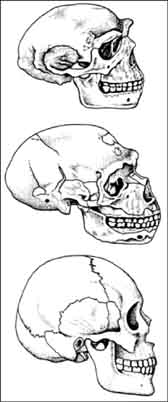A Remarkable Discovery in Sussex
Thus was the stage set for the initially rather innocuous announcement the appeared in the British science journal Nature on December 5,1912, concerning a fossil find in the Piltdown section of Sussex in southern England. The notice read, in part:
| Remains of a human skull and mandible, considered to belong to the early Pleistocene period, have been discovered by Mr. Charles Dawson in a gravel-deposit in the basin of the River Ouse, north of Lewes, Sussex. Much interest has been aroused in the specimen owing to the exactitude with which its geological age is said to have been fixed.... (p. 390) |
| The fossil human skull and mandible to be described by Mr. Charles Dawson and Dr. Arthur Smith Woodward at the Geological Society as we go to pressis the most important discovery of its kind hitherto made in England. The specimen was found in circumstances which seem to leave no doubt of its geological age, and the characters it shows are themselves efficient to denote its extreme antiquity. (p. 438) |
According to the story later told by those principally involved, in February 1912 Arthur Smith Woodward at the British Museum received a letter from Charles Dawson-a Sussex lawyer and amateur scientist. Woodward had previously worked with Dawson and knew him to be an extremely intelligent man with a keen interest in natural history. Dawson informed Woodward in the letter that he had come upon several fragments of a fossil human skull. The first piece had been discovered in 1908 by workers near the Barcombe Mills manor in the Piltdown region of Sussex, England. In 1911, a number of other pieces of the skull came to light in the same pit, along with a fossil hippopotamus bone and tooth.
In the letter to Woodward, Dawson expressed some excitement over the discovery and claimed to Woodward that the find was quite important and might even surpass the significance of Heidelberg Man, an important specimen found in Germany just the previous year.
[45]
�
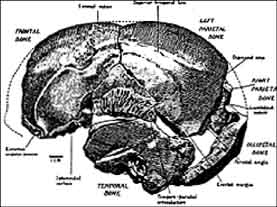
Figure 4.2 This drawing with anatomical labels of the fragmentary remains of the Piltdown cranium appeared in a book written by one of the fossil's chief supporters. (From The Evolution of Man, by Grafton Elliot Smith, Oxford University Press)
Due to bad weather, Woodward was not immediately able to visit Piltdown. Dawson, undaunted, continued to work in the pit, finding fossil hippo and elephant teeth. Finally, in May 1912, he brought the fossil to Woodward at the museum. What Woodward saw was a skull that matched his own expectations and those of many others concerning what a human ancestor should look like. The skull, stained a dark brown from apparent age, seemed to be quite modern in many of its characteristics. The thickness of the bones of the skull, however, argued for a certain primitiveness. The association of the skull fragments with the bones of extinct animals implied that an ancient human ancestor indeed had inhabited England. By itself this was enormous news; at long last, England had a human fossil (Figure 4.2).
Things were to get even more exciting for English paleontologists. At the end of May 1912 Dawson, Woodward, and Pierre Teilhard de Chardin- a Jesuit priest with a great interest in geology, paleontology, and evolution whom Dawson had met in 1909-began a thorough archaeological excavation at the Piltdown site (Figure 4.3). More extinct animal remains and flint tools were recovered. The apparent age of the fossils based upon comparisons to other sites indicated not only that Piltdown was the earliest human fossil in England, but also that, at an estimated age of 500,000 years, the Piltdown fossil represented potentially the oldest known human ancestor in the world.
Then, to add to the excitement, Dawson discovered one half of the mandible.
Though two key areas-the chin, and the condyle where the jaw connects to
the skull-were missing, the preserved part did not look anything like a
human jaw. The upright portion or ramus was too wide, and the bone
too thick. In fact, the jaw looked remarkably like that of an ape (Figure
4.4). Nonetheless, and quite significantly, the molar teeth exhibited humanlike
wear. The human jaw, lacking the large canines of apes, is free to move
from side to side while chewing. The molars can grind in a sideways motion
[46] in a manner impossible in monkeys or apes. The wear on human molars
is, therefore, quite distinct from that of other primates. The Piltdown
molars exhibited such humanlike wear in a jaw that was otherwise entirely
apelike.
�
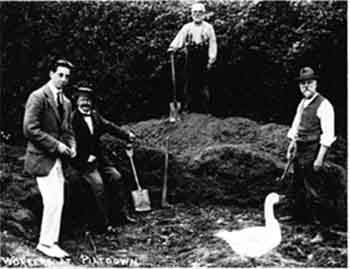
Figure 4.3 Paleontological excavations proceed at Piltdown. From left to right: Pierre Teilhard de Chardin [Ed. note: Robert Kenward, Jr.], Charles Dawson, an unidentified workman, a goose, and Arthur Smith Woodward. (From the Archives of the British Museum [Natural History])�

Figure 4.4 Comparison of the mandibles (lower jaws) of a young chimpanzee [left], modern human [right], and Piltdown [center]. Note how much more similar the Piltdown mandible is to that of the chimp, particularly in the absence of a chin. The presence of a chin is a uniquely human trait. (From Dawson and Woodward, 1913, The Geological Society of London)
That the skull and the jaw had been found close together in the same
geologically ancient deposit seemed to argue for the obvious conclusion
that they belonged to the same ancient creature. But what kind of creature
could it have been? There were no large brow ridges like those of
Java or Neandertal Man. The face was flat as in modern humans and not snoutlike
[47] as in the Neandertals. The profile of the cranium was round as it is
in modern humans, not flattened as it appeared to be in the Java and Neandertal
specimens (Figure 4.5). According to Woodward, the size of the skull indicated
a cranial capacity or brain size of at least 1,100 cc (Dawson and Woodward
1913), much larger than Java and within the range of modern humanity. Anatomist
Arthur Keith (1913) suggested that the capacity of the skull was actually
much larger, as much as 1,500 cc, placing it close to the modern mean. But
the jaw, as described above, was entirely apelike.
�
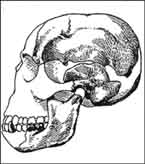
Figure 4.5 Drawn reconstruction of the Piltdown skull. The portion of the skull actually recovered is shaded. As reconstructed the cranium shows hominid (human) traits and the mandible shows pongid (ape) traits. Compare this drawing to those in Figure 4.1. With its humanlike head and apelike jaw, the overall appearance of the Piltdown fossil is far different from Homo erectus, Neandertal, or modern humans. (From The Evolution of Man, Grafton Elliot Smith, Oxford University Press)
The conclusion drawn first by Dawson, the discoverer, and then by Woodward, the professional scientist, was that the Piltdown fossil-called Eoanthropus dawsoni, meaning Dawson's Dawn Man-was the single most important fossil find yet made anywhere in the world. Concerning the Piltdown discovery, the New York Times headline of December 19, 1912, proclaimed "Paleolithic Skull Is a Missing Link." Three days later the Times headline read "Darwin Theory Is Proved True."
The implications were clear. Piltdown Man, with its modern skull, primitive jaw, and great age, was the evidence many human paleontologists had been searching for: an ancient man with a large brain, a modern-looking head, and primitive characteristics below the important brain. As anatomist G. E. Smith summarized it:
The brain attained what may be termed the human rank when the jaws and face, and no doubt the body also, still retained much of the uncouthness of Man's simian ancestors. In other words, Man at first, so far as his general appearance and "build" are concerned, was merely an Ape with an overgrown brain. The importance of the Piltdown skull lies in the fact that it affords tangible confirmation of these inferences. (Smith 1927:105 6)
[48] If Piltdown were the evolutionary "missing link" between apes and people, then neither Neandertal nor Java Man could be. Since Piltdown and Java Man lived at approximately the same time, Java might have been a more primitive offshoot of humanity that had become extinct. Since Neandertal was much more recent than Piltdown, yet looked more primitive where it really counted (that is, the head), Neandertal must have represented some sort of primitive throwback, an evolutionary anachronism (Figure 4.6).
By paleontological standards the implications were breathtaking. In one sweeping blow Piltdown had presented England with its first ancestral human fossil, it had shown that human fossils found elsewhere in the world were either primitive evolutionary offshoots or later throwbacks to a more primitive type, and it had forced the rewriting of the entire story of human evolution. Needless to say, many paleontologists, especially those in England, were enthralled by the discovery in Sussex.
In March 1913, Dawson and Woodward published the first detailed account of the characteristics and evolutionary implications of the Piltdown fossil. Again and again in their discussion, they pointed out the modern characteristics of the skull and the simian appearance of the mandible. Their comments regarding the modernity of the skull and the apelike characteristics of the jaw, as you will see, turned out to be accurate in a way that few suspected at the time.
Additional discoveries were made at Piltdown. In 1913 a right canine tooth apparently belonging to the jaw was discovered by Teilhard de Chardin. It matched almost exactly the canine that had previously been proposed for the Piltdown skull in the reconstruction produced at the British Museum of Natural History. Its apelike form and wear were precisely what had been expected: "If a comparative anatomist were fitting out Eoanthropus with a set of canines, he could not ask for anything more suitable than the tooth in question," stated Yale University professor George Grant MacCurdy (1914:159).
Additional artifacts, including a large bone implement, were found in 1914. Then, in 1915, Dawson wrote Woodward announcing spectacular evidence confirming the first discovery; fragments of another fossil human skull were found (possibly at a site just two miles from the first-Dawson never revealed the location). This skull, dubbed Piltdown II, looked just like the first with a rounded profile and thick cranial bones. Though no jaw was discovered, a molar recovered at the site bore the same pattern of wear as that seen in the first specimen.
Dawson died in 1916 and, for reasons not entirely clear, Woodward held
back announcement of the second discovery until the following year. When
the existence of a second specimen became known, many of those skeptical
after the discovery of the first Piltdown fossil became supporters. One
of those converted skeptics, Henry Fairfield Osborn, president of the American
Museum of Natural History, suggested:
�
| [49] If there is a Providence hanging over the affairs
of prehistoric man, it certainly manifested itself in this case, because the
three minute fragments of this second Piltdown man found by Dawson are exactly
those which we should have selected to confirm the comparison with the original
type. (1921:581) |
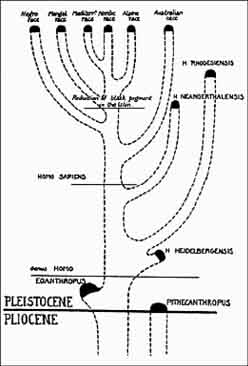
Figure 4.6 Among its supporters, Eoanthropus (Piltdown Man) was seen as more directly ancestral to modern humanity than either Homo erectus-here labeled Pithecanthropus and depicted as an entirely separate evolutionary pathway-or Neandertal- shown here as a short-lived diversion off the main branch of human evolution. (From The Evolution of Man Grafton Elliot Smith, Oxford University Press)
The Piltdown Enigma
There certainly was no unanimity of opinion, however, concerning the significance of the Piltdown discoveries. The cranium was so humanlike and the jaw so apelike that some scientists maintained that they simply were the fossils of two different creatures; the skeptics suggested that the association of the human cranium and ape jaw was entirely coincidental. Gerrit S. Miller, Jr. (1915) of the Smithsonian Institution conducted a detailed analysis of casts of Piltdown I and concluded that the jaw was certainly that of an ape (see Figure 4.4). Many other scientists in the United States and Europe [50] agreed. Anatomy professor David Waterston (1913) at the University of London, King's College, thought the mandible was that of a chimpanzee. The very well-known German scientist Franz Weidenreich concluded that Piltdown I was " . . . the artificial combination of fragments of a modern human braincase with an orangutan-like mandible and teeth" (1943:273).
Coincidentally or note, after Dawson's death no further discoveries were made in either the Piltdown I or II localities, though Woodward continued excavating at Piltdown through the 1920s.
Elsewhere in the world, however, human paleontology became an increasingly exciting and fruitful endeavor. Beginning in the late 1920s as many as forty individuals of a species now called Homo erectus were unearthed at Zhoukoudian, a cave near Beijing in China (see Figure 4.1). Ironically, David Black, anatomist at the Peking Union Medical College, who was instrumental in obtaining financial support for the excavation, had visited Grafton Elliot Smith's laboratory in 1914, and had become fascinated by the Piltdown find (Shapiro 1974). Further, Teilhard de Chardin participated in the excavation at the cave. The Zhoukoudian fossils were estimated to be one-half million years old. Also on Java, another large group of fossils (close to twenty) were found at Sangiran; these were similar to those from Zhoudoudian.
Also in the 1920s, in Africa, the discovery was made of a fossil given the name Australopithecus africanus. It was initially estimated to be more than one million years old. In the 1930s and 1940s additional finds of this and other varieties of Australopithecus were made. In Europe the number of Neandertal specimens kept increasing; and even in England, in 1935, a fossil human ancestor was discovered at a place called Swanscombe.
Unfortunately for Eoanthropus, all of these discoveries seemed to contradict its validity. The Chinese and Sangiran Homo erectus evidence pointed to a fossil ancestor with a humanlike body and primitive head; these specimens were quite similar to Java Man in appearance (Java Man is also now considered to belong to the species Homo erectus ), possessing large brow ridges, a flat skull, and a thrust-forward face while being quite modern from the neck down. Even the much older australopithecines showed clear evidence of walking on two feet; their skeletons were remarkably humanlike from the neck down, though their heads were quite apelike. Together, both of these species seemed to confirm the notion that human beings began their evolutionary history as upright apes, not as apelike people. Eoanthropus seemed more and more to be the evolutionary "odd man out."
How could Piltdown be explained in light of the new fossil evidence from China, Java, Europe, and Africa? Either Piltdown was a human ancestor, rendering all the manifold other discoveries members of extinct offshoots of the main line of human evolution, or else Piltdown was the remarkable coincidental find of the only known ape fossil in England within a few feet of a rather modern human skull that seemed to date back 500,000 years. Neither explanation sat well with many people.
[51] Unmasking the Hoax
This sort of confusion characterized the status of Piltdown until 1949, when a new dating procedure was applied to the fossil. A measurement was made of the amount of the element fluorine in the bones. This was known to be a relative measure of the amount of time bone had been in the ground. Bones pick up fluorine in groundwater; the longer they have been buried, the more fluorine they have. Kenneth Oakley of the British Museum of Natural History conducted the test. While the fossil animal bones from the i. site showed varying amounts of fluorine, they exhibited as much as ten times more than did either the cranium or jaw of the fossil human. Piltdown Man, Oakley concluded, based on comparison to fluorine concentrations in bones at other sites in England, was no more than 50,000 years old (Oakley and Weiner 1955).
While this certainly cast Piltdown in a new light, the implications were just as mysterious; what was a fossil human doing with an entirely apelike jaw at a date as recent as 50,000 years ago? Then, in 1953 a more precise test was applied to larger samples of the cranium and jaw. The results were quite conclusive; the skull and jaw were of entirely different ages. The cranium possessed .10 percent fluorine, the mandible less than .03 percent (Oakley 1976). The inevitable conclusion was reached that the skull and jaw must have belonged to two different creatures.
As a result of this determination, a detailed reexamination of the fossil was conducted and the sad truth was finally revealed. The entire thing had been a hoax. The skull was that of a modern human being. Its appearance of age was due, at least in part, to its having been artificially chemically stained. The thickness of the bone may have been due to a pathological condition (Spencer 1984) or the result of a chemical treatment that had been applied, perhaps to make it appear older than it was (Montague 1960).
Those scientific supporters of Eoanthropus who previously had pointed out the apelike character of the jaw were more right than they could have imagined; it was, indeed, a doctored ape jaw, probably that of an orangutan. When Gerrit Miller of the Smithsonian Institution had commented on the broken condyle of the mandible by saying, "Deliberate malice could hardly have been more successful than the hazards of deposition in so breaking the fossils as to give free scope to individual judgement in fitting the parts together," (1915:1) he was using a literary device and not suggesting that anyone had purposely broken the jaw. But that is likely precisely what happened. An ape's jaw could never articulate with the base of a human skull, and so the area of connection had to be removed to give "free scope" to researchers to hypothesize how the cranium and jaw went together. Otherwise the hoax would never have succeeded. Beyond this, the molars had been filed down to artificially create the humanlike wear pattern. The canine tooth had been stained with an artist's pigment and filed down to [52] simulate human wear; the pulp cavity had been filled with a substance not unlike chewing gum.
It was further determined that at least one of the fragments of the Piltdown II skull was simply another piece of the first one. Oakley further concluded that all the other paleontological specimens had been planted at the site; some were probably found in England, but others had likely originated as far away as Malta and Tunisia. Some of the ostensible bone artifacts had been carved with a metal knife.
The verdict was clear; as Franz Weidenreich (1943) put it, Piltdown was like the chimera of Greek mythology-a monstrous combination of different creatures. The question of Piltdown's place in human evolution had been answered: it had no place. That left still open two important questions: who did it and why?
Whodunit?
The most succinct answer that can be provided for the question "Whodunnit?" is "No one knows." It seems, however, that every writer on the subject has had a different opinion.
Each of the men who excavated at Piltdown has been accused at one time or another (Figure 4.7). Charles Dawson is an obvious suspect. He is the only person who was present at every discovery. He certainly gained notoriety; even the species name is dawsoni. Blinderman (1986) points out, however, that much of the evidence against Dawson is circumstantial and exaggerated. Dawson did indeed stain the fossil with potassium bichromate and iron ammonium sulfate. These gave the bones a more antique appearance, but such staining was fairly common. It was felt that these chemicals helped preserve fossil bone, and Dawson was quite open about having stained the Piltdown specimens. In an unrelated attack on his character, some have even accused Dawson of plagiarism in a book he wrote on Hastings Castle (Weiner 1955), but this seems to be unfair; as Blinderman points out, the book was explicitly a compilation of previous sources and Dawson did not attempt to take credit for the work of others.
Dawson's motive might have been the fame and notoriety that accrued to this amateur scientist who could command the attention of the world's most famous scholars. But there is no direct evidence concerning Dawson's guilt, and questions remain concerning his ability to fashion the fraud. And where would Dawson have obtained the orangutan jaw?
Arthur Smith Woodward certainly possessed the opportunity and expertise to pull off the fraud. His motive might have been to prove his particular view of human evolution. That makes little sense though, since he could not have expected the kind of confirming evidence he knew his colleagues would demand. Furthermore, his behavior after Dawson's death [53] seems to rule out Woodward as the hoaxer. His fruitlessly working the original Piltdown pit in his retirement renders this scenario nonsensical.
Even the priest Teilhard de Chardin has been accused, most recently
by Harvard paleontologist and chronicler of the history of science Stephen
Jay Gould (1980). The evidence marshalled against the Jesuit is entirely
circumstantial, the argument strained. The mere facts that Teilhard mentioned
Piltdown but little in his later writings on evolution and was confused
about the precise chronology of discoveries in the pit do not add up to
a convincing case.
�
�
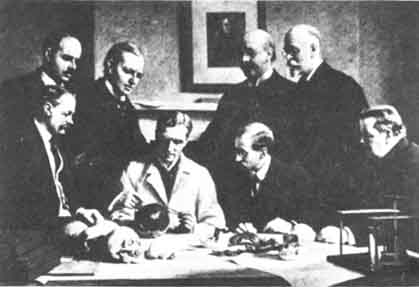
Figure 4.7 Portrait of scientists examining a number of specimens including Eoanthropus in 1915. From right to left, standing: A. S. Woodward, Charles Dawson, G. E. Smith, and F. O. Barlowe; from right to left, seated: E. R. Lankester, W. P. Pycraft, A. Keith, and A. S. Underwood. (From the Archives of the British Museum [Natural History])
Others have had fingers pointed at them. W. J. Sollas, a geology professor at Oxford and a strong supporter of Piltdown, has been accused from beyond the grave. In 1978, a tape-recorded statement made before his death by J. A. Douglas, who had worked in Sollas's lab for some thirty years, was made public. The only evidence provided is Douglas's testimony that on one occasion he came across a package containing the fossil-staining agent potassium bichromate in the lab-certainly not the kind of stuff to convince a jury to convict.
Even Sir Arthur Conan Doyle has come under the scrutiny of would-be Piltdown detectives. Doyle lived near Piltdown and is known to have visited the site at least once. He may have held a grudge against professional scientists who belittled his interest in and credulity concerning the [54]
paranormal. Doyle, the creator of the most logical, rational mind in literature, Sherlock Holmes, found it quite reasonable that two young English girls could take photographs of real fairies in their garden. But why would Doyle strike out at paleontologists, who had nothing to do with criticizing his acceptance of the occult? Again, there is no direct evidence to implicate Doyle in the hoax.
The most recent name added to the roster of potential Piltdown hoaxers is that of Lewis Abbott, another amateur scientist and artifact collector. Blinderman (1986) argues that Abbott is the most likely perpetrator. He had an enormous ego and felt slighted by professional scientists. He claimed to have been the one who directed Dawson to the pit at Piltdown and may even have been with Dawson when Piltdown II was discovered (Dawson said only that he had been with a friend when the bones were found). Abbott knew how to make stone tools and so was capable of forging those found at Piltdown. Again, however, the evidence, though tantalizing, includes no smoking gun.
A definitive answer to the question "whodunnit" may never be forthcoming. The lesson in Piltdown, though, is clear. Unlike the case for the Cardiff Giant where scientists were not fooled, here many were convinced by what appears to be, in hindsight, an inelegant fake. It shows quite clearly that scientists, though striving to be objective observers and explainers of the world around them, are, in the end, human. Many accepted the Piltdown evidence because they wished to-it supported a more comfortable view of human evolution. Furthermore, perhaps out of naivete, they could not even conceive that a fellow thinker about human origins would wish to trick them; the possibility that Piltdown was a fraud probably occurred to few, if any, of them.
Nevertheless, the Piltdown story, rather than being a black mark against science, instead shows how well it ultimately works. Even before its unmasking, Piltdown had been consigned by most to a netherworld of doubt. There was simply too much evidence supporting a different human pedigree than that implied by Piltdown. Proving it a hoax was just the final nail in the coffin lid for this fallacious fossil. As a result, though we may never know the hoaxer's name, at least we know this: if the goal was to forever confuse our understanding of the human evolutionary story, the hoax ultimately was a failure.
Current Perspectives
Human Evolution �
With little more than a handful of cranial fragments, human paleontologists defined an entire species, Eoanthropus, and recast the story of human [55] evolution.. Later, in 1922, on the basis of a single fossil tooth found in Nebraska, an ancient species of man, Hesperopithecus, was defined. It was presumed to be as old as any hominid species found in the Old World and convinced some that then-current evolutionary models needed to be overhauled. The tooth turned out to belong to an ancient pig. Even in the case of Peking Man, the species was defined and initially named Sinanthropus pekinensis on the basis of only two teeth.
Today, the situation in human paleontology is quite different. The tapestry of our human evolutionary history is no longer woven with the filaments of a small handful of gauzy threads. We can now base our evolutionary scenarios (Figure 4.8) on enormous quantities of data supplied by several fields of science (see Feder and Park 1989 for a detailed summary of current thinking on human evolution).
Australopithecus afarensis, for example, the oldest known hominid,
dating to more than 3.5 million years ago, is represented by more than a
dozen fossil individuals. The most famous specimen, known as "Lucy,"
is more than 40 percent complete. Its pelvis is remarkably modern and provides
clear evidence of its upright, and therefore humanlike, posture. Its skull,
on the other hand, is quite apelike and contained a brain the size of a
chimpanzee's. We even have a preserved pathway of footprints dating to the
time when Lucy and her cohorts walked the earth, showing as dramatically
as possible that they did so in a bipedal, humanlike fashion.
�
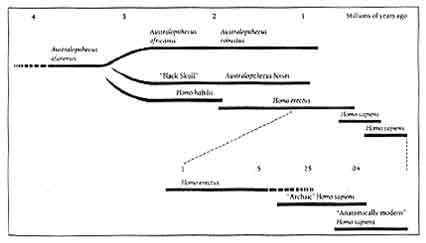
Figure 4.8 Current human evolutionary chronologies are based on a large body of paleontological archaeological, and genetic data. There is no room for-and no need for-a precociously large-brained human ancestor like Eoanthropus in the human pedigree. (From Human Antiquity, Feder and Park, Mayfield Publishing)
Homo erectus is known from dozens of individuals-forty from Zhoukoudian alone, nearly twenty from Java, and more than a dozen from Africa. In Kenya, the 80 percent complete skeleton of a twelve-year-old Homo erectus boy has been dated to more than 1.5 million years ago.
Archaic forms of Homo sapiens, especially the famous Neandertals, number in the hundreds. The fossil human record is rich and growing. Our evolutionary scenarios are based, not on a handful of fragmentary bones, but on the remains of hundreds of individuals. Grafton Elliot Smith, Arthur Smith Woodward, and the others were quite wrong. The abundant evidence shows very clearly that human evolutionary history is characterized by the precedence of upright posture and the tardy development of the brain. It now appears that while our ancestors developed upright posture and humanlike bodies more than 3.5 million years ago, the modern human brain did not develop until as recently as 100,000 years ago.
Beyond this, human paleontologists are no longer restricted solely to the paleontological record. Exciting techniques of genetic analysis have allowed scientists to develop measures of difference between living species, including humans and our nearest extant relatives, the apes. Genetic "clocks" have been crafted from the results of such techniques.
For example, through DNA hybridization, scientists can quantify the difference between the genetic codes of people and chimpanzees. Here, an attempt is made to bond human and chimp DNA, much in the way the separate strands of the DNA double helix bond to produce the genetic code for a single organism. It turns out that the DNA of our two species is so similar that we can form a nearly complete bond. The opinion of most is that our two species could have split evolutionarily no more than five or six million years ago.
New dating techniques based on radioactive half-lives, biomechanical analysis of bones, scanning electron microscopy in bone and artifact exam)" nation, and many other new forms of analysis all make our evolutionary scenarios more concrete. It is to be expected that ideas will change as new data are collected and new analytical techniques are developed. Certainly, our current views will be fine-tuned, and perhaps even drastic changes o opinion will take place. This is the nature of science. It is fair to suggest however, that no longer could a handful of enigmatic bones that contradicted our mutually supportive paleontological, cultural, and genetic data bases cause us to unravel and reweave our evolutionary tapestry. Today, the discovery of a Piltdown Man likely would fool few.
�